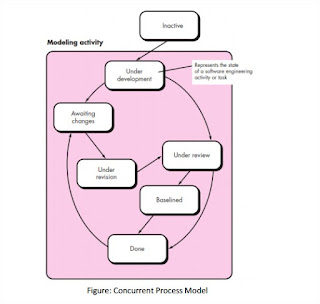Concurrent Model | Concurrent Engineering
Concurrent Model
- The
concurrent development model, sometimes called concurrent engineering.
- It allows a software team
to represent iterative and concurrent elements of any of the process model.
- For example, the modeling
activity defined for the spiral model is accomplished by invoking one or more
of the software engineering actions: prototyping, analysis, and design.
- The activity—modeling—may
be in any one of the states noted at any given time.
- Similarly, other activities, actions, or tasks (e.g.,
communication or construction) can be represented in an similar manner.
- All
software engineering activities exist concurrently but reside in different
states.
- For example, early in a project the communication
activity (not shown in the figure) has completed its first iteration and exists
in the awaiting changes state.
- The modeling activity (which existed in the inactive
state while initial communication was completed, now makes a transition into
the under development state. If, however, the customer indicates that changes
in requirements must be made, the modeling activity moves from the under
development state into the awaiting changes state.
- Concurrent modeling defines a series of events that
will trigger transitions from state to state for each of the software
engineering activities, actions, or tasks.

Thanks for the information, You can get here best Supply Chain & Warehouse Management software here.
ReplyDeleteits really helpful..
ReplyDelete